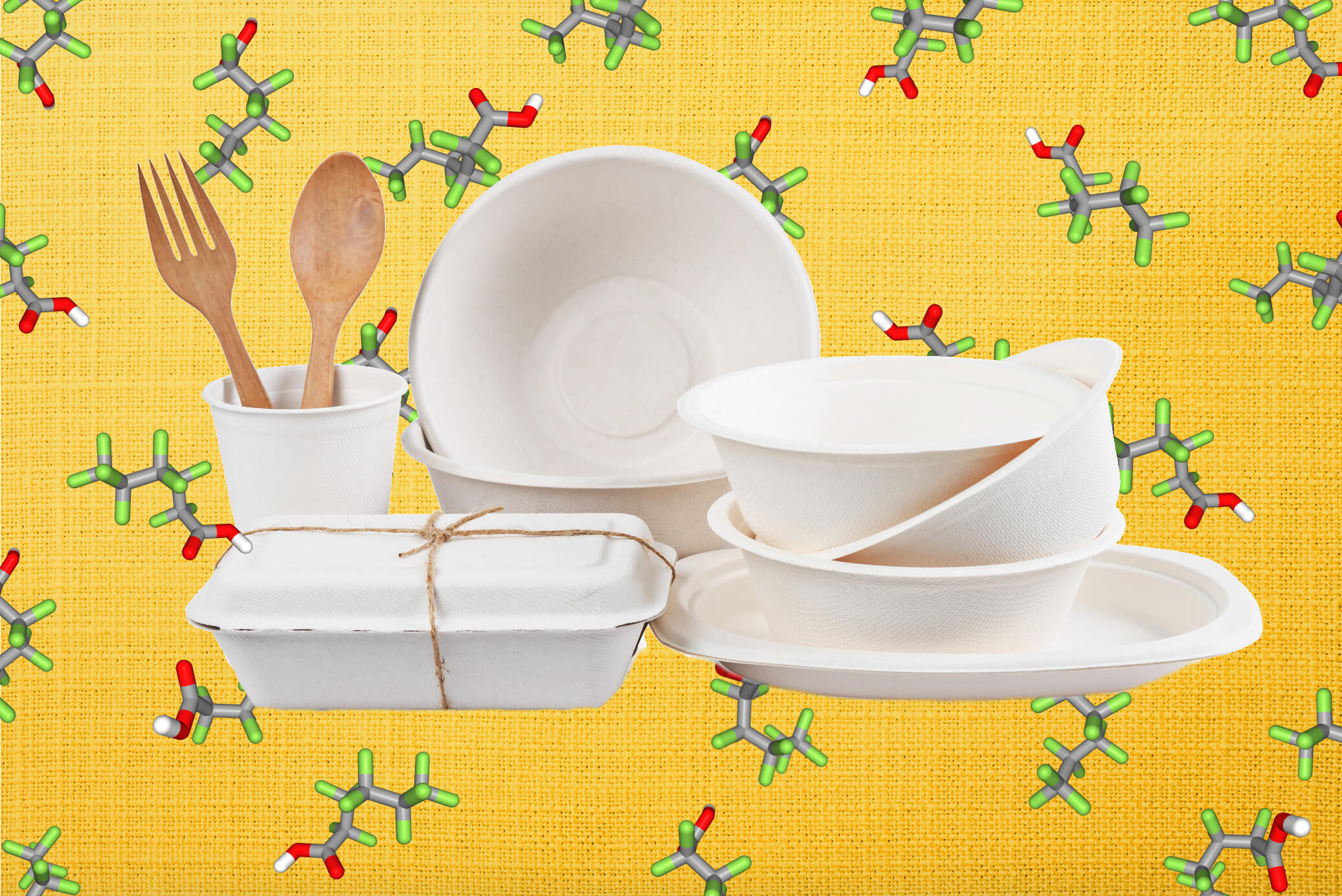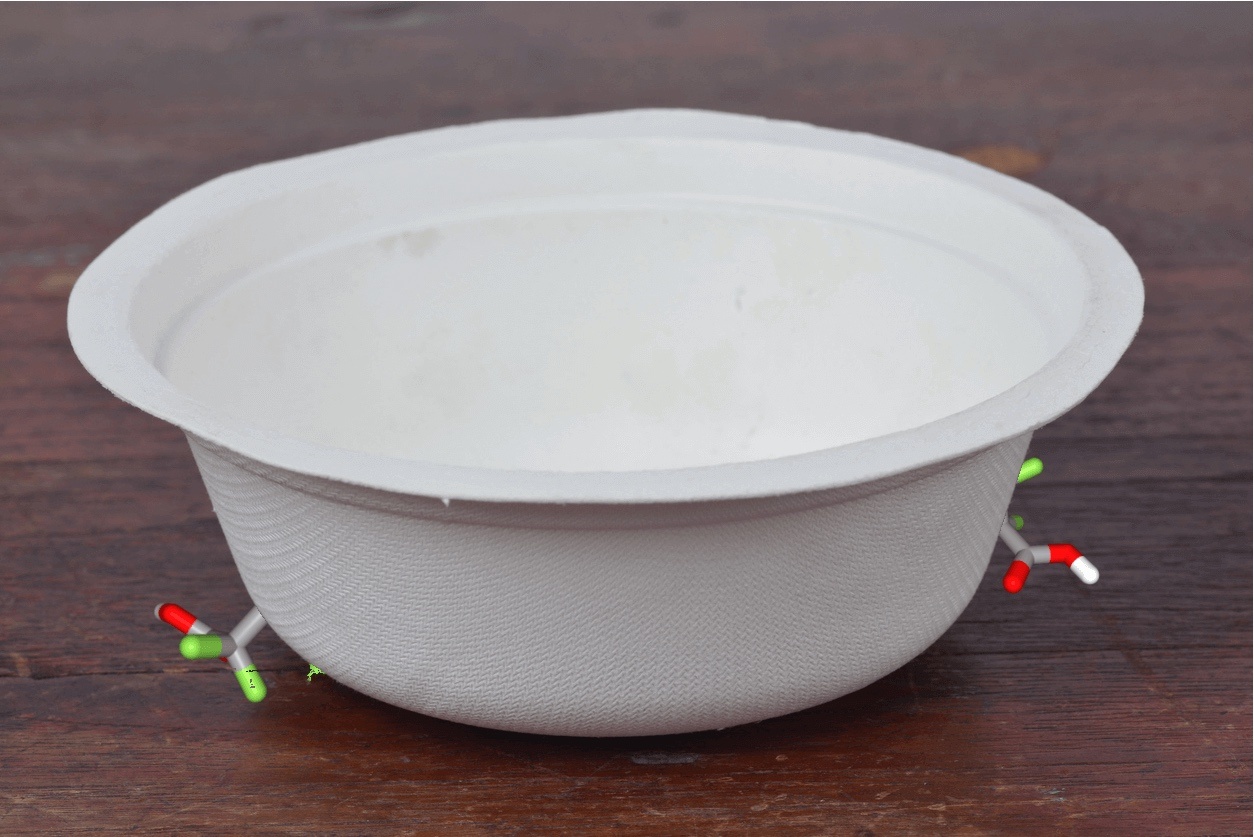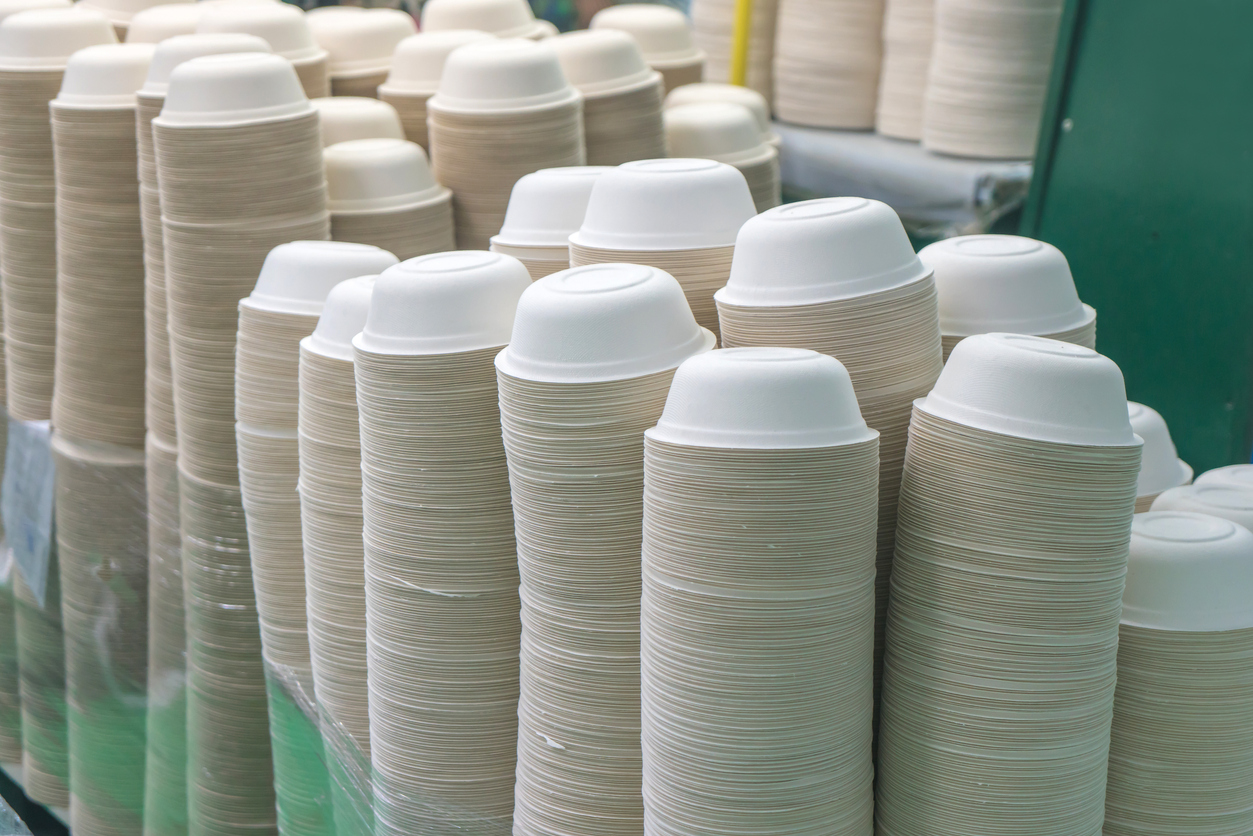
iStock / The New Food Economy
Restaurants selling “compostable” plant-fiber bowls insist their products are safe. But a major review of existing research on “short-chain” PFAS is unequivocal: There is cause for serious concern.
On Friday, a group of Auburn University scientists published a major review of existing research on “short-chain” PFAS, a ubiquitous variety of fluorinated “forever chemicals” commonly found in a wide range of consumer products. Their consensus? We know next to nothing about the safety of these chemicals, which have characteristics of high concern and are in urgent need of further study.
Perhaps even more alarming was this: Short-chain PFAS may ultimately prove to be more dangerous than “long-chain” PFAS, the older, notoriously harmful compounds they were designed to replace. I reported on the presence of short-chain PFAS in the plant-based bowls popular at restaurants like Chipotle and Sweetgreen in a New Food Economy investigation published earlier this month.
PFAS, or per- and polyfluoroalkyl substances, are a broad class of more than 4,000 chemicals used in carpets, textiles, electronics, cookware, and other goods. Because the long-chain varieties have been definitively linked to serious health outcomes in humans, including thyroid conditions, reproductive issues, and various forms of cancer, U.S. companies began to voluntarily phase them out in the early 2000s. And in the past five years, the Food and Drug Administration (FDA) has banned entirely the import and manufacture of some kinds of long-chain PFAS. But manufacturers never stopped relying on PFAS. They just started using the short-chain variety instead, many of which are approved for commercial uses, and which were thought to be less hazardous.
Now, a growing body of research casts doubt on the presumed safety of short-chain PFAS. In their extensive review, the Auburn University scientists strike an unequivocal note: There is cause for serious concern.
“While long-chain PFAS have been the center of active research in the past decade or so, and while industrial production and applications of short-chain PFAS continue to rise, very few studies have focused on the occurrence, fate, and transformation of short-chain PFAS in the environment,” they wrote, in the peer-reviewed Chemical Engineering Journal. Short-chain PFAS, they added, “may pose more risks on the human and ecosystem health” than long-chain PFAS do.

While short-chain PFAS are already widely dispersed throughout the environment and in our bodies, the longer-term sublethal effects of this dispersal simply are not known
The Counter / iStock / PubChem
I’ll say more about their findings in a minute. But first, what’s the difference between short-chain and long-chain PFAS? Though there’s more background on that topic in my investigation, here’s a quick primer. PFAS vary widely in chemical compostion, but all are made up of large molecules containing many carbon-fluorine bonds. These powerful ionic bonds function like atomic-level armor, making PFAS molecules nearly invulnerable to attack from the microbes and enzymes that typically break substances down in the environment. This attribute also makes them fantastically good at repelling grease and water, which is why they’ve been so useful to industry in applications from raincoats and stain-proof carpets to non-stick pans and food packaging. Long-chain PFAS are longer molecules that typically feature eight carbon atoms. Short-chain PFAS typically contain six or fewer carbons.
By now, it’s confirmed that long-chain PFAS are terrible for the human body. As these risks became increasingly well-documented, industry worked with FDA to pivot away from long-chain PFAS. In general, those compounds were replaced by short-chain PFAS, which were presumed to be safer, since they stay in the human body for shorter periods of time—not years, the way some long-chain PFAS can, but months or days.
But short-chain varieties of PFAS are still extremely persistent, able to remain in the environment for unknown periods of time, perhaps longer than 1,000 years. (That’s where the “forever chemicals” nickname applies.) For that reason, it was surprising to discover that they’re present in the plant-based takeout bowls sold at popular restaurants, including bowls that are billed “compostable.”
Current research shows an alarming data gap when it comes to potential health effects of short-chain PFAS.
My investigation showed that virtually all molded fiber takeout bowls contain PFAS, likely the short-chain variety that FDA still permits in some forms of food packaging. The New Food Economy tested 18 plant-based bowls from eight different New York City restaurants, and found that all of them contained high levels of fluorine, which multiple experts told me means they were treated with PFAS. Far from being compostable, then, these bowls contain compounds that can’t biodegrade in composting facilities or in the environment more generally. Instead, they’re adding to the planet’s toxic stock of fluorinated “forever chemicals” and are likely making compost, soil, and water quality worse.
But are these products harmful to our health? Some from the restaurant industry answered this question by pointing out that the chemicals used in their bowls are approved by FDA: “[Our] suppliers operate under strict guidelines set forth by the FDA, and have provided Chipotle with certification that all raw material and finished pulp products fully meet the FDA regulatory guidelines for the safe use of only approved PFAS,” a spokesperson for the company wrote in an email statement provided for my piece.
It’s true that restaurants like Chipotle are operating within existing guidelines. While it might be misleading to call a bowl “compostable” if it contains chemicals that don’t degrade, that practice isn’t breaking any laws or rules. But that’s where the Auburn University study comes in. The scientists’ review of current research showed an alarming data gap when it comes to potential health effects of short-chain PFAS.
“For short-chain especially, we really don’t have enough risk data,” says Dongye Zhao, an Auburn University scientist who co-authored the report. “You cannot say these compounds are toxic or non-toxic based on the data we collected. Very little work has been done on the toxicity and environmental risks.”
Zhao says that he and his colleagues found fewer than five limited studies that directly examined links between short-chain PFAS and human health. That’s an astonishing oversight, considering the widespread use of these chemicals. There are thousands of varieties of PFAS in use today, and dozens approved by FDA for use in food packaging. When it comes to compostable bowls, then, we simply don’t know enough about what we’re eating off of—not to mention putting into compost, soil, and groundwater.
Even considering that lack of information, the Auburn study concluded that short-chain PFAS may prove to be even more dangerous than their long-chain counterparts. That determination was reached for three distinct reasons.
The short-chain PFAS used in plant-based bowls are more likely to contaminate groundwater.
First, short-chain PFAS are much more mobile than long-chain PFAS. That means they’re more likely to disperse throughout our environment, contaminating water systems instead of remaining in localized waste sites. The Auburn report, which collected a significant body of water quality research in one place for the first time, shows how this dispersal has already started to happen. According to the study, short-chain PFAS can now be detected at high concentrations in lakes and rivers in eastern China, the Ganges River, which flows through India and Bangladesh, waterways in the coastal U.S., the E.U.’s Rhine River basin, and at lower concentrations in polar snow and ice. The study also cites research showing that short-chain PFAS are more mobile in soil. From there, they can be absorbed by fruit and vegetable crops, meaning that we’re more likely to ingest them directly through food.
That mobility is troubling for another reason. While short-chain PFAS are more likely to migrate through waterways, they’re also much harder to filter out. Zhao and his colleagues cite research showing that activated carbon (AC) filters can effectively remove long-chain PFAS from water, but that same research found that AC fails to remove short-chain. The authors spend pages describing potential technologies that may be able to remove and degrade short-chain PFAS, from polymeric resins to nanofiltration and reverse osmosis. But for now, the study concludes, none of the available approaches are sufficient to remove short-chain PFAS from our water. “There is an urgent need for characterizing the environmental behavior of short-chain PFAS and developing cost-effective removal technologies,” the authors write.
“They are probably even harder to deal with from an environmental compatibility standpoint,” Zhao says.

Starting January 1, 2020, the Biodegradable Products Institute (BPI), a leading assessor of compostable dishware, will no longer certify any product that contains more than 100 parts per million total fluorine. The bowls we tested contained more than 15 times that amount of fluorine.
iStock / Casanowe
That finding is relevant when it comes to compostable takeout packaging. As I pointed out in my investigation, exposure to PFAS through bowl contact is likely to be minor, though more research is necessary in that arena. But University of Notre Dame professor Graham Peaslee, the chemist who tested bowls for The New Food Economy, told me that the real issue is water quality. When bowls are composted and spread on field crops, 100 percent of the PFAS ends up leaching out of the product, much of it likely ending up in soil and groundwater. Bowls that end up in the landfill are also problematic, Peaslee told me, because “that means 100 percent of the chemicals are coming off. Not just the one-tenth or one-hundredth of a percent that comes off in food contact, but 100 percent of it you’ll be drinking in two months. Because it goes right through the landfill treatment.”
“They are probably even harder to deal with from an environmental compatibility standpoint.”
But short-chain PFAS don’t just travel more easily through public waterways. The Auburn study shows that they also travel more easily through the systems of the human body. While long-chain PFAS are more “biopersistent,” meaning that they take longer for the body to excrete, short-chain PFAS are more “bioavailable,” meaning that they enter the bloodstream more easily. As a result, they tend to permeate some vital organs at much higher rates, according to research Zhao and his team reviewed.
For instance, a Spanish study of autopsy tissues found that one particular strain of short-chain PFAS tends to cluster in the kidneys at concentrations 100 times higher than long-chain PFAS, and in the lungs at concentrations six times higher. Zhao says he finds that troubling, since the longer term effects of such exposures are still unknown.
In an email about the Auburn study, Peaslee tells me that he thinks it’s a “scarily accurate” review of current scientific knowledge. But he added that the study, if anything, downplayed the health risks related to the bioavailability of short-chain PFAS.
Short-chain PFAS tend to permeate some vital organs at much higher rates.
“The industrial producers of PFAS are insistent that commercial products no longer contain the long-chain PFAS, and that because the lifetimes of these short-chain PFAS in the blood of rodents exposed to them is shorter, that they are “safe,” Peaslee writes. “But this overlooks an important facet of exposure science. Once it gets into the body, the short-chain PFAS are more likely to penetrate the blood/organ membrane and actually travel into organs more readily (and differently) than long-chain PFAS. Thus, while I think everything in this review is accurate in my opinion, they underestimate the toxicity of these short-chain PFAS because of the complicated interplay between how much is out there, how much gets into humans, and how long it sticks in each organ.”

Notre Dame chemist Graham Peaslee says the Auburn University study is a “scarily accurate” review of current scientific knowledge.
iStock / The New Food Economy
Peaslee also pointed out another finding that was largely omitted from the study: PFAS as a class have been found to be immunotoxic, meaning that they weaken the body’s ability to fend off disease, which can increase susceptibility to certain opportunistic cancers, as well as other conditions. “It is very difficult to prove the cluster of rare cancers are due to PFAS directly in any one group, and we don’t know how badly short-chain PFAS suppress the human immune system,” Peaslee writes. “There is evidence that it isn’t as bad as longer-chain PFAS, but it is not zero. And there are more of them entering the bloodstream.”
“It’s just a hard problem to crack.”
At this stage, restaurants using molded fiber products face a difficult choice. Current regulations tell them that they’re doing nothing wrong by selling salads and burrito bowls in receptacles that have been treated with PFAS. But a mounting body of evidence suggests the regulations don’t go far enough. At the same time, at least one major U.S. city—San Francisco—is enacting an effective ban on fluorinated takeout packing. Starting January 1, 2020, the Biodegradable Products Institute (BPI), a leading assessor of compostable dishware, will no longer certify any product that contains more than 100 parts per million total fluorine. (The bowls we tested contained more than 15 times that amount of fluorine, on average.) That means in San Francisco, where restaurants are required to use BPI-certified takeout packaging, plant-based bowls will be off the menu—unless, in a few short months, manufacturers can find a way to develop a molded fiber product that works just as well without PFAS.
For now, no such solution exists.
“It’s just a hard problem to crack,” says Aseem Das, founder and CEO of World Centric, a Petaluma, California-based food packaging manufacturing company, which Das says supplies Sweetgreen and other leading restaurants with its bowls. “We’ve been trying to find a solution over the past year and a half to see what can work, and not end up costing a lot more in terms of the final product, or end up causing large-scale changes to the way the manufacturing is done.”
Das did not dispute any of the Auburn study’s findings on a phone call with me, though he pointed out that direct food exposure from PFAS-treated bowls is a lesser problem than how those bowls perform in the environment once thrown away. For its part, the National Restaurant Association (NRA), the leading trade group representing restaurateurs, is sticking by its argument that short-chain PFAS are safe.
“Service, safety and hospitality are key priorities for the restaurant industry,” says Laura Abshire, NRA’s director of food and sustainability policy. “The Food and Drug Administration has approved these substances for food contact based on scientific data which demonstrates they are safe for their intended use. Restaurants work with their suppliers to ensure their packaging meets FDA requirements as well as those of consumers.”
But other restaurant chains that rely daily on molded fiber bowls seem to recognize that change is necessary.
“The health and safety of our guests is the number one priority at Sweetgreen and transparency has always been at the core of our business,” wrote a company spokesperson, in a statement emailed to The New Food Economy. “We originally introduced compostable containers to make a positive impact on the food ecosystem, but given recent concerns around PFAS, we’re actively working with new and existing suppliers to find a more sustainable and compostable solution.”



